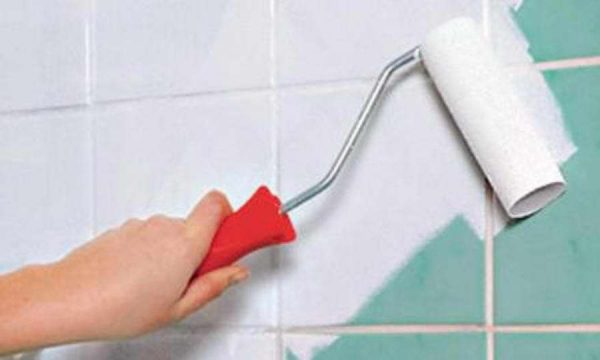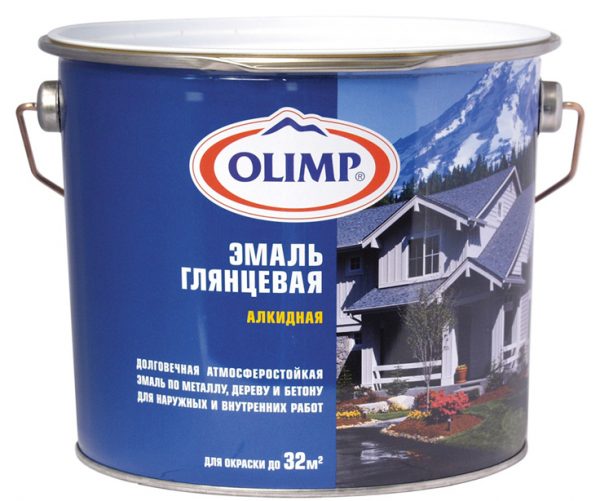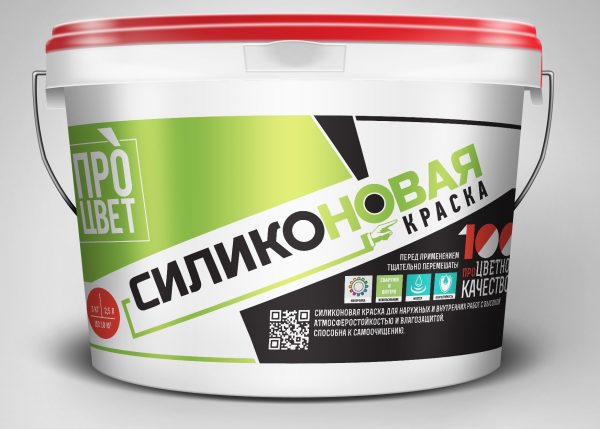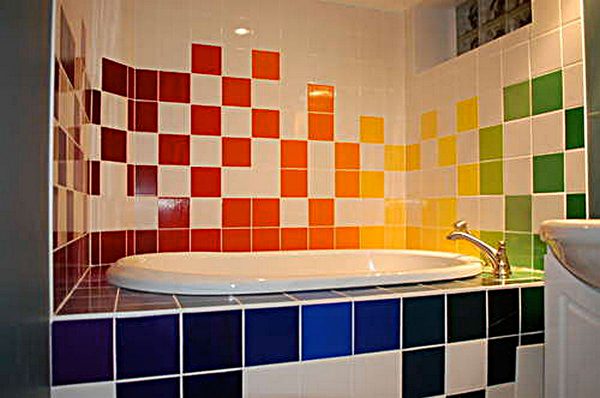Over time, the tile becomes dull, losing its original appeal. Replacing tiles is an expensive and not always justified undertaking. It’s much easier to update coverage. Paint for tiles will help to do this.
- Staining purposes
- Varieties of paint
- Alkyd Enamels
- Polyurethane
- Epoxy enamel
- Latex water-dispersion paints
- Silicone
- Oil
- Car enamels
- Decorative paint
- Specialized paints
- Color selection
- Self-painting tiles
- Paint application
- Tile lacquering

Staining purposes
The ceramic surface is easy to paint. Painted tiles on the walls, floor or ceiling will remain attractive for many years.
If it is a tile in damp rooms, it is not recommended to paint it. No matter what the waterproof paint is, the properties of the tile coating are such that it will not work to provide reliable adhesion in conditions of high humidity, the paint will begin to peel off. This does not mean that it is impossible to paint the tiles in the bathroom. Painting is acceptable, but the service life of the coating will not be too long.
Tile painting pursues the following goals:
- Aesthetic appeal. Old tiles in the kitchen or in the bathroom look ugly. To give the surface attractiveness will help its coloring. If you wish, you can not just apply a layer of new paint, but also decorate the coating by applying patterns or drawings.
- Waterproofing. Paintwork improves the water-repellent properties of the surface.
Varieties of paint
The main property of the paint, with the exception of the decorative effect, is its ability to adhere to the base (adhesion). Otherwise, staining will not bring a long-term effect, the paintwork will begin to peel off. Adhesion is determined not only by the quality of the paint, but also by the material to be painted. Best of all, the paint adheres to a gypsum surface, but tile due to its smoothness does not allow perfect adhesion.
The paint must be resistant to all kinds of negative environmental influences, including humidity, water, high and low temperatures. The coating should not be destroyed as a result of contact with cleaning agents.
There are two main types of coating - matte and glossy. There are intermediate types between these varieties - semi-gloss and semi-gloss coatings. Each type of coating corresponds to certain characteristics:
- The matte surface looks noble, allows you to favorably display the relief structure of the tile. Defects are not striking.
- The glossy surface looks more solemn, visually expands the room. On glossy coatings, the slightest flaws are noticeable - chips, stains, etc.
Note! If necessary, you can not paint the entire tile, but only the seams. For this purpose, special paints and varnishes are on sale.

Alkyd Enamels
Alkyd formulations are based on alkyd varnish (pentaphthalic or glyphthalic) in combination with fillers and a solvent. Pigmenting substances are added to the enamel, giving the composition the desired color.
Advantages of alkyd enamels:
- excellent polymerization;
- affordable cost;
- ability to withstand aggressive environments (humidity, cleaning products);
- ease of use.
The disadvantages of alkyd enamels include the fragility of the coating, instability to ultraviolet radiation, toxicity. Before applying alkyd enamel, priming the surface is mandatory to ensure reliable adhesion during further staining.
to contents ↑Polyurethane
They produce polyurethane paints and varnishes from special compounds - polyols. Advantages of this type of paint:
- low cost;
- environmental friendliness;
- resistance to abrasive wear, temperature differences and humidity.
Polyurethane coatings are characterized by good adhesive characteristics. Another feature of polyurethane paints and varnishes is the formation of a very flexible and durable coating.
The disadvantage of polyurethane paints is incompatibility with any other coatings. It is impossible to apply such paint to an old paintwork.
to contents ↑Epoxy enamel
They are made on the basis of epoxy resins. Form a coating of high strength. However, the surface is more solid than elastic. Epoxy enamels are notable for good adhesive characteristics.
to contents ↑Note! For epoxy and polyurethane enamels, primers suitable only for organic solvents are suitable. Universal primers are not used.
Latex water-dispersion paints
They are distinguished by excellent adhesion. The paint holds well not only on porous and rough surfaces, but also on smooth materials, including tiles.
An important advantage of latex formulations is their high moisture resistance. Latex paints and varnishes are environmentally friendly, free from unpleasant odors. It is not necessary to prime the surface before applying latex paint, since the composition adheres well to the surface even without it.
to contents ↑Silicone
Made from silicone resins. Differs in high vapor permeability and moisture resistance. It can be used as facade paint. Silicone compounds are suitable for painting balconies and damp rooms.
to contents ↑Oil
The drying oil acts as the basis of the oil composition. The main advantage of oil paint is low cost. Currently, such paints and varnishes are practically not used for coloring tiles due to many disadvantages:
- toxicity;
- the presence of a pungent odor;
- long drying time.
Oil coatings quickly turn yellow, as a result of which the tile loses its appeal.
to contents ↑Car enamels
Initially, enamels were used only for painting cars. Recently, they are often used for processing other types of surfaces. The enamel contains resin, a pigmenting agent, a hardener and a solvent. Auto enamel is ideally suited for painting smooth, including ceramic, granite surfaces.
to contents ↑Decorative paint
This group includes paints and varnishes that give surfaces a special look. As a rule, we are talking about imitating any material (“stone-like”, brick, wood, etc.). The composition of decorative paint includes polymer and mineral additives.
Specialized paints
This group of paints is intended to give the surface special qualities. For example, Zinga protects the coating from moisture. There are compositions that protect the material from fire ("Polystyle" and "Counterfire").
Color selection
How the tile will be perceived after painting depends on the choice of colors and their combination. The color background can be annoying, contribute to a surge of energy or, conversely, act soothingly.
It is recommended to avoid bright colors, even if they seem very beautiful. The bright background quickly tires, aggressively affecting the psyche. The best option is neutral tones, merging with the rest of the room. On a neutral background, the flaws made when staining the tiles are not so noticeable.
If desired, you can give the coloring of liveliness, using several colors of paint at once. It is possible to apply ornaments and drawings (for example, apply patterns at the corners of the floor tiles). This is done manually or using stencils. In the latter case, even an amateur will be able to complete the painting.
to contents ↑Advice! When applying several colors to the tile, you need to monitor the harmony of their combination. Otherwise, instead of the original coloring, a lurid daub will turn out.
Self-painting tiles
To paint the tiles with your own hands, you will need a set of tools and materials:
- sandpaper with small grains;
- primer (preferably epoxy);
- paint rollers;
- brushes;
- tray for paint;
- rags;
- solvent;
- masking tape;
- degreasing compound;
- paint;
- varnish.
Before proceeding with painting, you need to carefully prepare the surface. Preparatory work includes the following activities:
- We free the room from furniture, household appliances, interior items. We cover large items that cannot be cleaned with polyethylene so as not to stain them with paint.
- We clean the tiles with detergent. An abrasive powder or acid is suitable: both products do an excellent job of removing dirt and grease.
- We wash off the detergent composition from the surface, wipe the tile with a rag. We are waiting for the tiles to dry.
- In addition, degrease the tile with acetone or gasoline.
- We process the tile with sandpaper.
- Instead of sandpaper, you can use ordinary sand. Pour sand onto a sponge and rub the tile with it. The goal is the same as with sandpaper - to create a slightly rough surface for better adhesion to the paint. Another option is the processing of tiles with a metal sponge.
- We remove the formed dust with a dry rag or vacuum cleaner.
- Primed the surface. Apply the primer with a brush. We do not allow the formation of sagging, especially at the seams.
- We close the joints with putty.
- We plinth the plinths with tape so as not to stain them with paint in the future.
to contents ↑Note! Seams should be cleaned out especially carefully, since most dirt accumulates there. If dirt remains on the seams, fungus will appear in these areas after painting.
Paint application
There are several approaches to painting tiles:
- Capital painting. Assumes a complete color change.
- Color update. The color background does not change, and the only goal is to update the existing coat of paint. It is only necessary to make the color background more intense.
- Creation of drawings or patterns. It is performed both on the old paint layer and on the new one.
When performing painting work, care should be taken about safety measures. To do this, put on work clothes, rubber gloves, safety glasses and a hat.
The sequence of actions for painting tiles:
- Stir the paint thoroughly. The composition should acquire a uniform consistency.
- Pour the paint into a paint tray or other utensils in which it is convenient to dip the roller / brush. For processing large surfaces, it is recommended to use a paint roller, and only paint corners and hard-to-reach spots with a brush.
- The paint is applied in several layers, the amount of which is determined by the relief of the tile: if it is smooth, you will need 3-5 layers. Paint begins to be applied from the opposite corner from the exit from the room.
- Each layer is applied after drying the previous one. Drying time of the coating depends on the type of paint, air temperature and humidity. On average, it takes 6 to 12 hours to dry the layer.
- When the last coat of paint is applied, you should wait three days: after that, you can walk on the floor.This also applies to walls: within 72 hours, it is better not to touch the walls, otherwise traces may remain on the coating.
Tile lacquering
To further protect the paint layer, it is recommended to process the already painted tiles with varnish. Thanks to the varnish, the coating becomes more resistant to moisture. It is not so easy to wash off the paint layer from the varnished surface. The film formed after varnishing serves as a barrier to abrasion of the paint.
Before applying varnish, make sure that the composition does not harm the paint. To do this, select a small area of the painted surface and apply a small amount of varnish there. We look at the reaction. If the paint is not damaged within a few hours, varnish the remaining area.
If you want to keep the original color of the painted surface, it is recommended to use a glossy varnish. Formulations with a matte effect will change the original color. Oil-based varnishes are undesirable: they give the coating a yellowish tint.















